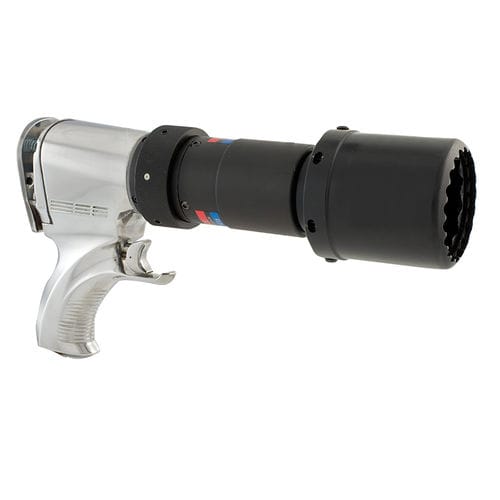
#Industry News
Improving Joint Integrity and Preventing Leaks In The Water Industry With HYTORC's Industry Leading Bolting Solutions
Clean Water Losses - Out of Sight Out of mind? Is It Acceptable?
In 2010 ‘The Deepwater Horizon’ oil spill lost an estimated 757 Million Litres of Oil in total... In England and Wales, it is estimated that we lose 3.1 Billion Litres of water per day, due to leakage!!
In volume total terms ‘The Deepwater Horizon’ problem lost barely a quarter of what the UK CCW (Consumer Council of Water) feel we lose per day in clean water. However, because it’s H2O being lost to ground and not a dirty black highly visible crude oil, it goes largely un-noticed.
Let’s start with a basic of why you should read further……….
Do we really lose 3.1 Billion Litres of clean water per day?
I guess you don’t believe me, because it’s hard to picture a billion litres? Well just do a Google search. ‘how much water is lost to ground by leaking pipes?’. I just did a search and the first hit on Google from 2017 suggested that an estimated 3.1 Billion Litres are lost per day in the UK. Around the world it’s a similar picture that you’ll find from all of your searches too, wherever you live.
But what does 3.1 Billion Litres look like?
(3.1 billion Litres = 3,100,000,000 Litres = 3.1 Million metric tonnes)……or a canal that is 10m wide X 10m deep X 31km in length, being lost into the ground each and every day!!
Now imagine that was oil again and ask yourself if it is acceptable?
So is this level of leakage ok because it’s water and not oil and does it matter?
The answer to that question is really simple, YES it does matter, and NO its not acceptable, even if it is just water!
Whichever way we look at it, it’s not acceptable. Someone out there could calculate the carbon footprint of the wasted energy to process 3.1 Bn Tonnes of water? Or maybe the financial impact on the consumer for water that never reaches their homes? Or maybe the subsurface wash away, erosion and environmental damage caused by the movement of such volumes of water…None of these are acceptable, to any of us.
So what can the Water Industry learn from the Oil & Gas Industries?
20+ years ago the Oil and Gas industries identified an elephant in the room. That elephant being the question, Why are some key factors of pipework regulated, but some equally important factors weren’t, yet they were quite often the cause of a leak.
So 20+ years ago, what factors were and weren’t regulated?... Imagine this for your own involvement in the water Industry?
Regulated to industry Standards
a) Pipe materials, production process and finished pipe section.
b) Flange materials, dimensions and manufacture process.
c) Welding the flange to the pipe, by a qualified welder to the correct welding standards.
Outcome….all pipe length including flanges were of a controlled high standard.
Unregulated 20 years ago
a) The process of bolting one pipe connection flange to the next.
b) The training/qualification of the engineers carrying out the bolting task.
c) The torque control of each bolt at the flange and how this impacts bolt load, flange stress and gasket stress.
Outcome… Enormous level of variation in practice and bolted joint integrity was questionable.
Question – A Chain is only as strong as it’s weakest link, isn’t it?
So why have such strict regulations for the pipes, flanges and the welding of the two together? To then have near zero regulation of how one pipe section is bolted to the next? Is the bolting of two flanges together of less importance than the welding of a flange to the pipe section? Doesn’t that make it the weakest link in the chain?
Isn’t this approach just as insane as having a climbing rope made to a regulated quality and standard, but not the D-Link or hook? Or quality control of the house bricks but no attention taken to the cement mix used in the building process.
Free Webinars to help you improve your understanding of bolting!
During these difficult and challenging times, HYTORC are running a number of ‘Free to attend’ webinars, to help you understand bolting and the importance of a correct bolting procedure. We’ll answer and help you understand a few of the following myths and fables.
What am I really doing when I tighten a nut or a bolt?
Should I use a washer?
What effect does a lubricant have on bolting?
What are the pro’s and cons of fine thread versus course thread?
What is bolting scatter?
Why have a tightening pattern that I should follow?
What happens when I overtighten a bolt?
What is the correlation between torque and pre-load?
What is pre-load?
How can I improve the safety of my bolting process?
….Plus many more factors which could help you push towards improving your bolting processes and becoming leak free by helping you control all the ‘controllable’ factors.
Follow https://library.hytorc.com/posts/3106 for a Preview of Safe Bolting Principles & Practices. This is not a HYTORC sales based webinar but more of a training aide or introduction to bolting. Other upcoming webinars can be found at https://hytorc.com/webinar with many of them focused on a particular sector or topic.
If anyone has any additional questions or wants to find out more about what HYTORC are doing to ensure the quality of connections while improving on Safety, Speed and Accuracy, please contact HYTORC on info@hytorc.co.uk







